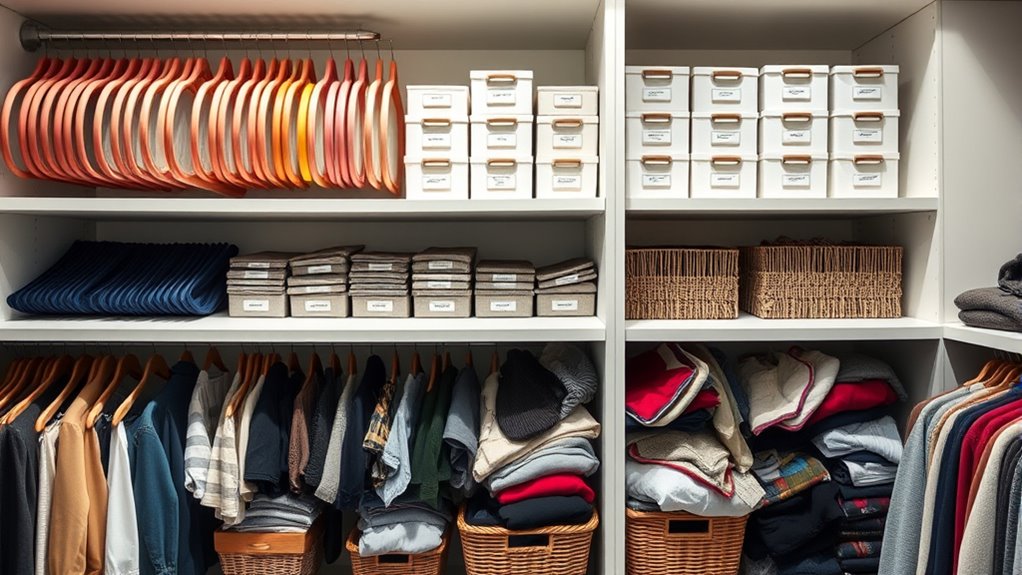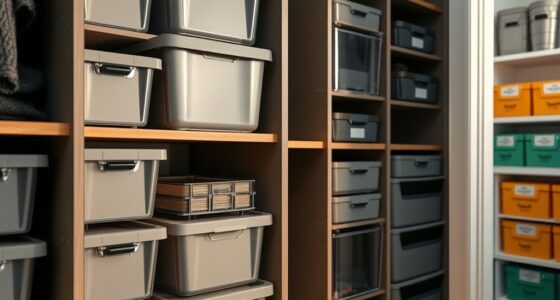Your closet organization system might be failing because it’s likely a generic, off-the-shelf design, made with low-quality materials, and not tailored to your space or needs. These systems often don’t maximize your space, leave dead zones, and don’t adapt as your wardrobe changes. If you want to stop wasting time and reduce clutter, understanding how a custom solution can transform your space is essential—keep going to discover how.
Key Takeaways
- Using off-the-shelf closet systems with generic designs ignores your unique space and storage needs, leading to inefficiency.
- Low-quality materials like pressboard and plastic hardware cause sagging, warping, and early system failure over time.
- Poorly planned layouts leave dead zones and underutilized vertical or corner spaces, increasing clutter.
- Lack of customization prevents optimal storage for specific items, resulting in disorganization and difficulty maintaining order.
- Insufficient planning and material durability issues cause systems to break down, making your closet organization unreliable.
The Common Pitfalls of Off-the-Shelf Closet Systems

Off-the-shelf closet systems often seem like a quick fix, but they come with significant drawbacks. These off-the-shelf storage solutions are mass-produced using low-grade materials like pressboard or flimsy plastic, which can sag or break over time. Designed to fit standard dimensions, they lack customization, leading to wasted space, dead zones, and awkward gaps that reduce storage efficiency. The one-size-fits-all approach doesn’t account for your unique closet layout or specific needs, making the system less functional and more likely to be abandoned. Plus, they often don’t accommodate the variety of items you store, such as shoes, accessories, or bulky clothing. Their generic design also means they tend to look plain and lack durability, requiring frequent repairs or replacements. Additionally, these systems often lack flexibility, preventing you from adapting your storage as your needs evolve over time.
Why DIY Solutions Often Miss the Mark

Many DIY closet solutions fall short because they lack the precise measurements and customization needed for an efficient layout. Without a custom fit, dead zones and awkward gaps form, wasting valuable space and making organization difficult. Mass-produced materials from big box stores often don’t withstand daily use, causing shelves to sag and hardware to break. Off-the-shelf designs also ignore your unique storage needs and space irregularities, resulting in cluttered, inefficient layouts. Many DIY solutions overlook tailored features like adjustable shelving, corner storage, or specialized compartments, which are essential for long-term organization. Without professional planning, these systems prioritize quick assembly over durability and functionality, leading to frequent reorganization efforts and frustration. Additionally, storage customization is often neglected in DIY projects, which can significantly impact the effectiveness of your closet system. Poorly designed self-watering plant pots can also contribute to clutter if they are not tailored to the specific needs of your plants and space. Incorporating space optimization techniques can help ensure your closet remains functional and clutter-free over time. Moreover, understanding the importance of personality traits can assist in selecting organizational methods that suit your habits and preferences, ultimately improving your satisfaction with your space. Ultimately, DIY solutions often fall short in providing a truly organized, lasting closet. Moreover, incorporating spiritual energy awareness into your planning process can help you create a space that feels more aligned and harmonious, enhancing your overall well-being.
The Limitations of One-Size-Fits-All Closet Designs
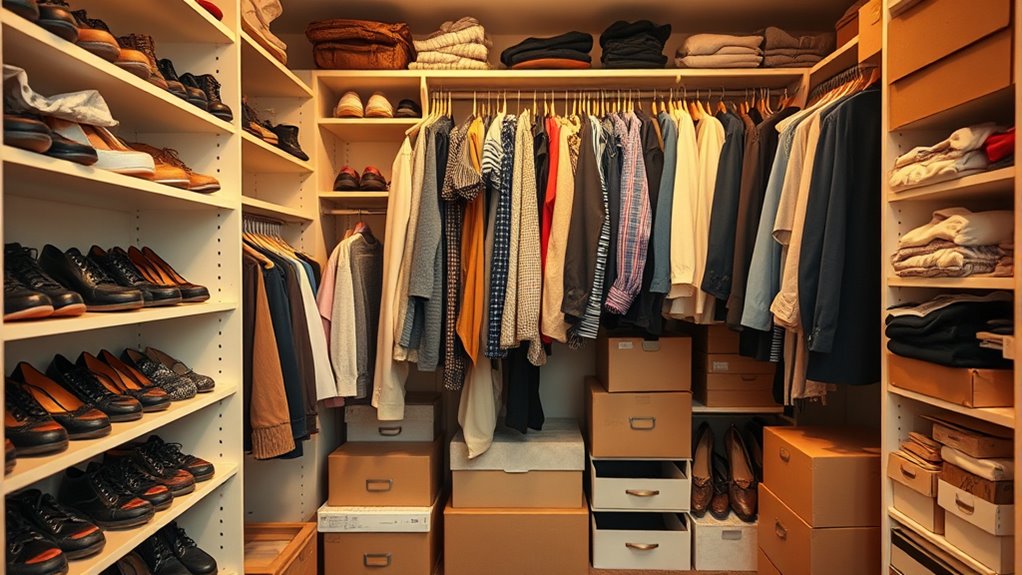
One-size-fits-all closet designs often fall short because they are made from low-quality materials like pressboard or flimsy plastic, which can sag or break under daily use. These generic closet designs don’t consider your specific storage needs or space dimensions, leading to inefficient use of your closet. Standard systems lack customization options, making it hard to store long dresses, bulky winter gear, or accessories properly. They also fail to utilize corners, dead spaces, and vertical areas, causing clutter and wasted potential. Because of their limited flexibility, these designs often require costly modifications or replacements sooner, reducing their durability and value. If your closet isn’t tailored to your unique storage needs, it’s bound to fall short over time, leaving you frustrated and disorganized. Additionally, choosing home furnishings that are durable and customizable can significantly improve the longevity and functionality of your closet system. Embracing personalized storage solutions can help maximize space and ensure your closet adapts to your evolving needs. Moreover, incorporating attention to detail in your design process can lead to better-organized and more efficient storage.
How Lack of Personalization Leads to Clutter

When a closet isn’t personalized to your specific needs, clutter quickly becomes unavoidable. Without customization, your storage solutions won’t fit your unique wardrobe, leading to misplaced or piled items. Shoes, accessories, and seasonal clothing often don’t have designated spaces, making it tempting to stuff or shove them into corners. A lack of personalization results in inefficient space use, so you might leave items out or create cluttered piles. When your closet organization doesn’t reflect your habits and preferences, maintaining order becomes an uphill battle. Over time, disorganization worsens, and clutter accumulates, making it harder to find what you need. Recognizing the importance of vertical storage solutions can help you create a space that resonates with your energy and lifestyle, promoting better organization. Incorporating customized storage options tailored to your wardrobe can significantly enhance your closet’s efficiency and prevent clutter from taking over. Personalization is key to creating effective storage that keeps your closet neat and prevents clutter from taking over.
The Importance of Space Optimization and Custom Planning

Optimizing space through custom planning is essential for creating a functional and efficient closet. When you tailor storage solutions to your specific needs and dimensions, you prevent dead zones and maximize every inch. Proper space optimization involves analyzing both vertical and horizontal areas, including corners and above doorways, to boost storage capacity. Using detailed measurements and 3D design tools helps you craft a layout that fits all your items without clutter or wasted space. Incorporating adjustable shelving, double-hanging rods, and specialized compartments adds flexibility as your storage needs change over time. Paying attention to spatial awareness ensures your closet layout is both practical and adaptable. Additionally, considering market growth projected at over 40% CAGR in AI tech by 2025, you can incorporate smart solutions that enhance organization and efficiency. By leveraging hybrid technologies, you can further streamline your closet management and access. Embracing innovative storage options can help you stay ahead of evolving trends and maximize your space. A well-designed, personalized closet system not only reduces clutter but also improves accessibility and longevity, ensuring your space remains organized and functional for years to come. Incorporating space-saving furniture can also be a game-changer for smaller areas.
The Hidden Dead Spaces That Sabotage Your Organization
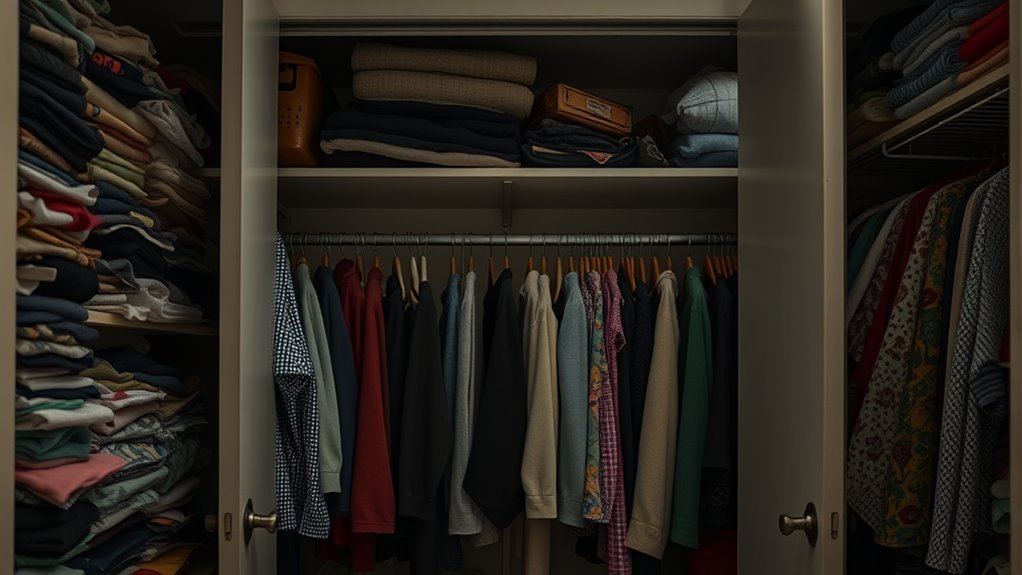
You might not realize it, but unused corner spaces and overlooked top shelves can silently sabotage your closet’s organization. These dead zones waste valuable storage and make it harder to find what you need. Addressing these hidden areas is key to maximizing your closet’s potential. Incorporating effective storage solutions can help utilize these neglected spaces and keep your closet organized.
Unused Corner Spaces
Unused corner spaces in your closet often become dead zones that are hard to access and even harder to keep organized. These corner spaces, if left untreated, turn into wasted space and clutter magnets, disrupting your closet organization. Traditional shelving units usually don’t maximize these areas, creating gaps known as the Bermuda Triangle of closets. Without proper planning, clothes and accessories pile up out of reach, making it easy to forget what’s tucked away. To fix this, consider installing custom angled shelves or rotating carousels designed specifically for corners. These solutions transform dead zones into functional storage areas, allowing you to utilize every inch of your closet efficiently. Properly managing corner spaces prevents clutter buildup and ensures your closet stays neat and accessible.
Overlooked Top Shelves
Many closet top shelves are set at heights that waste valuable vertical space, creating dead zones that quickly turn into clutter hotspots. These overlooked top shelves hinder your closet system’s efficiency, leaving hidden areas unused. Overstuffed or poorly measured shelves cause leaning stacks, making items hard to access and increasing disorganization. Shelves placed too low or too close together prevent proper stacking, leading to items falling or hiding in dead space. Failing to optimize adjustable shelving or increase shelf height wastes high-ceiling space. Ignoring the potential above the top shelf results in clutter buildup and inefficient storage. To maximize your vertical space, consider adjusting shelf heights and utilizing the full height of your closet system.
| Shelf Height | Storage Efficiency |
|---|---|
| Too Low | Poor stacking and access |
| Too Close | Items fall or hide |
| Adjustable | Better space utilization |
| Unused Vertical | Clutter buildup |
The Impact of Poor Material Choices on Closet Durability
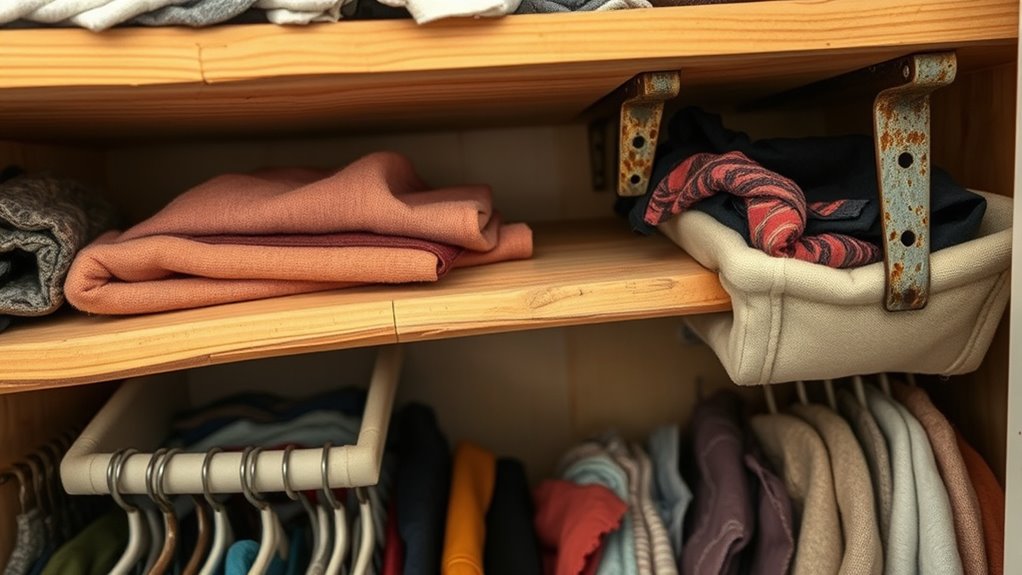
Choosing low-quality materials for your closet can lead to quick deterioration and frustration. Flimsy pressboard and plastic hardware often break or sag within a year, making your system unreliable. Investing in better materials pays off by ensuring your closet stays functional and looks good longer.
Low-Grade Pressboard Deterioration
Low-grade pressboard is a common material in closet systems, but it often fails under normal use. This material is prone to swelling, warping, and disintegration when exposed to moisture or humidity, leading to visible damage. Over time, the flimsy construction causes shelves and drawers to sag, crack, or break, compromising the entire system’s stability. The adhesive and particle-board components in low-quality pressboard degrade quickly, resulting in peeling surfaces and exposed core material. Frequent use and heavy loads accelerate this deterioration, making shelves unstable and hardware prone to failure. Poor material choices like low-grade pressboard drastically reduce your closet’s lifespan, often forcing costly repairs or replacements within just a few years. Its inability to withstand everyday wear and tear ultimately undermines your organization efforts.
Flimsy Plastic Hardware Failures
Plastic hardware in closet systems often fails because it lacks the strength to support everyday use. You’ll notice that cheap plastic components bend or break under the weight of clothing and accessories, leading to constant repairs. Low-grade plastic hinges and brackets crack easily when subjected to daily stress or heavy loads, making your closet less stable. Over time, these plastic parts become brittle and yellowed, diminishing both safety and appearance. Poor material quality means plastic hardware can’t handle humidity or temperature changes, accelerating deterioration. As a result, your closet system becomes unstable, with sagging shelves and misaligned doors. In short, flimsy plastic hardware undermines the durability of your closet, forcing you to replace parts frequently and frustrating your organizational efforts.
Short Lifespan of Cheap Materials
Poor material choices substantially shorten the lifespan of your closet system. Cheap materials like low-grade pressboard and flimsy plastic are prone to sag, warp, or break within a year. Inferior hardware, such as weak brackets and screws, often loosen or strip, causing shelves and rods to collapse. Low-quality finishes and paints quickly chip, peel, or fade, making your closet look worn out fast. These cheap materials lack the strength to support heavy items like winter coats, resulting in sagging shelves and drooping rods. As a result, your closet needs constant repairs or replacements, reducing its long-term value.
- Low-grade pressboard warps easily
- Flimsy plastic parts break quickly
- Weak hardware loosens over time
- Poor finishes chip or fade fast
- Short lifespan leads to frequent replacements
Failing to Match Storage Solutions to Your Unique Needs

Many off-the-shelf closet systems miss the mark because they’re designed for the average user, not your specific needs. These standardized solutions often ignore your closet’s unique dimensions, item types, and access habits. Cloning generic units creates dead space, awkward gaps, and underused areas, making organization harder. Without proper customization, your closet can’t support all your items—shoes, bags, seasonal clothing—leading to clutter. To truly optimize, match storage solutions to your lifestyle. For example:
| Your Needs | Standard Closet Design |
|---|---|
| Multiple shoe racks | Limited shoe storage |
| Adjustable space for bags | Fixed compartments, awkward fit |
| Seasonal clothing access | No dedicated sections |
| Easy access to daily items | Inflexible shelving |
Aligning storage solutions with your needs ensures better organization, durability, and visual harmony.
The Benefits of Tailored Closet Systems for Long-Term Use
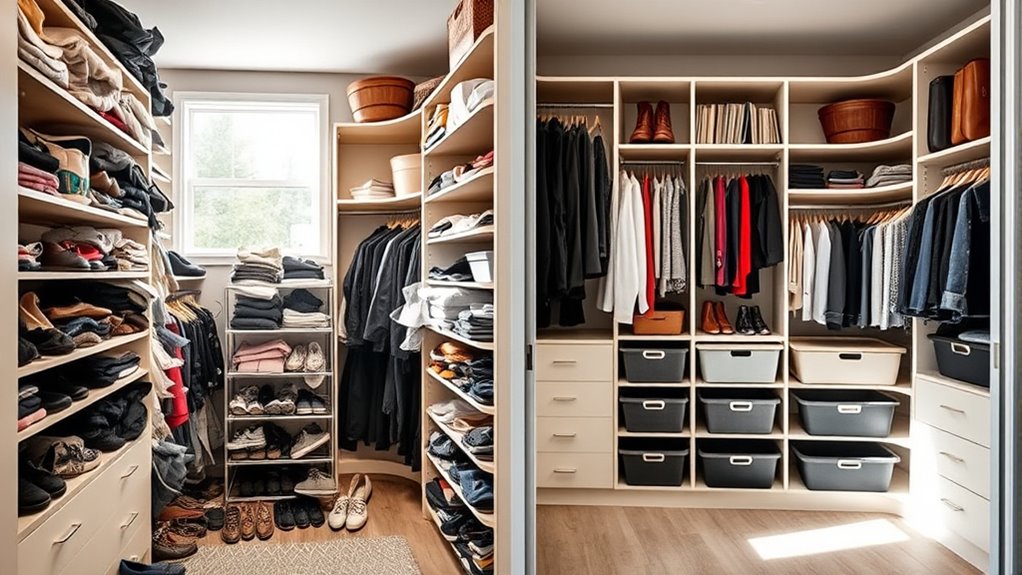
A tailored closet system offers long-term benefits by maximizing your storage space and ensuring durability. With a custom closet, you get optimized space efficiency, reducing dead zones and making every inch count. Personalized configurations allow you to organize shoes, accessories, and clothing for quick access and less clutter. These systems are built with high-quality, durable materials that resist warping, sagging, and breakage over time, ensuring lasting function. Additionally, features like adjustable shelving, pull-out drawers, and dedicated zones adapt to your changing needs. Investing in a custom closet not only improves organization but also adds value to your home by creating a stylish, functional space that stands the test of time. This tailored approach keeps your closet efficient and reliable for years to come.
How a Custom Approach Can Transform Your Closet and Your Life
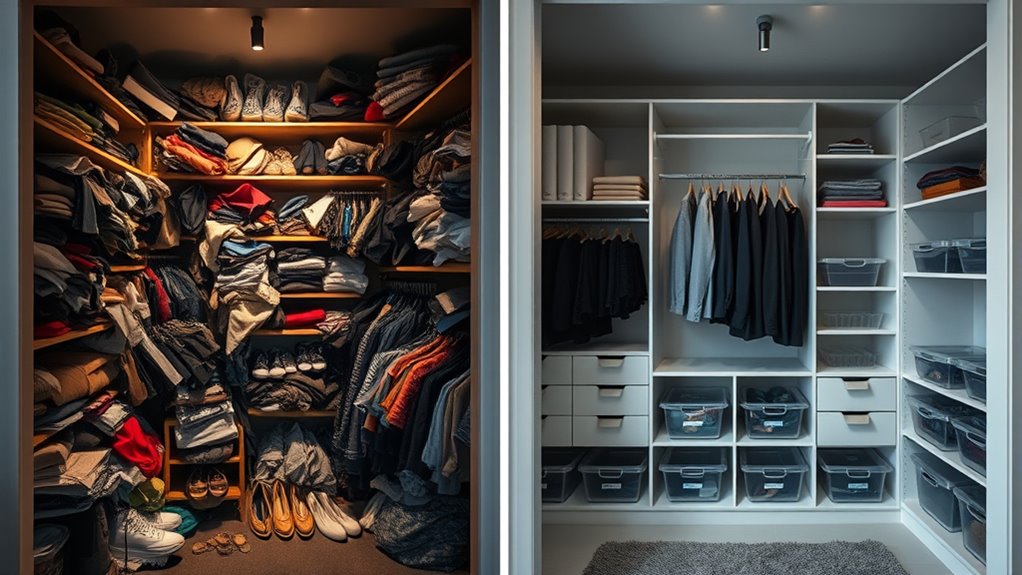
Choosing a custom closet system transforms not only your storage space but also your daily routine. When you invest in a personalized design, you maximize every inch, turning awkward corners and dead spaces into functional areas. A custom closet is tailored to your specific needs, ensuring your clothes, shoes, and accessories are organized efficiently. With high-quality materials and adjustable features, your system remains durable and adaptable as your wardrobe evolves. Professional design tools, like 3D visualization, let you see and tweak your plan before installation, avoiding costly mistakes. The result? A clutter-free space that simplifies mornings, reduces stress, and creates a more harmonious home environment. A custom approach truly has the power to transform your closet—and your life.
Frequently Asked Questions
How Can I Customize My Closet to Fit My Daily Routine?
To customize your closet for your daily routine, start by analyzing your wardrobe needs. Keep frequently worn items within easy reach, and organize by category or color for quick access. Use adjustable shelves, dividers, and storage bins to adapt to changing needs. Incorporate specific zones for work, casual, and workout clothes. Regularly declutter, and tweak the setup as your routines evolve to keep everything functional and efficient.
What Signs Indicate My Current System Isn’t Working Long-Term?
Like a house built on shifting sands, your closet system may seem fine until chaos erupts. If you’re constantly digging through piles, clothes are hard to find, or you feel overwhelmed by clutter, these are warning signs. Your system isn’t adapting to your needs. Long-term, it’ll break down further, making everyday routines stressful. Recognize these signs early, and consider rethinking your organization to restore harmony and efficiency.
How Often Should I Reassess My Closet Organization?
You should reassess your closet organization every three to six months. Regular check-ins help you identify clutter, unused items, or storage issues before they become overwhelming. During these reviews, evaluate whether your system still fits your lifestyle and adjust accordingly. By staying proactive, you guarantee your closet remains functional, tidy, and tailored to your needs, preventing long-term chaos and making daily dressing easier and more efficient.
Can a Personalized System Prevent Future Clutter Buildup?
Imagine your closet as a garden; a personalized system acts like a tailored watering schedule, nurturing growth while preventing weeds of clutter. By customizing your approach, you set clear boundaries and routines, ensuring items stay organized and don’t overrun your space. This proactive method helps you spot trouble early, keeping your closet tidy and functional, so clutter never gets a foothold, and your space remains a sanctuary.
What Are the Key Features of an Adaptable Closet Design?
An adaptable closet design features adjustable shelves, versatile hanging rods, and modular storage options that grow with your needs. You’ll find configurations that accommodate different clothing types and sizes, making organization effortless. With flexible accessories like pull-out drawers and customizable compartments, you’ll easily reconfigure your space. This approach guarantees your closet remains functional and clutter-free, adapting seamlessly to your changing wardrobe and lifestyle.
Conclusion
Your closet is more than just a storage space—it’s a reflection of your life. When you settle for generic solutions, you risk turning chaos into clutter. But with a tailored system designed around your needs, you can reclaim your space and serenity. Imagine opening your closet to find everything effortlessly in its place—like a well-orchestrated symphony. Don’t let one-size-fits-all hold you back; design your closet to truly serve you.
